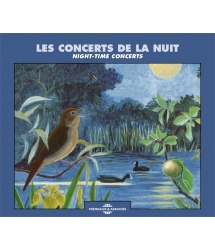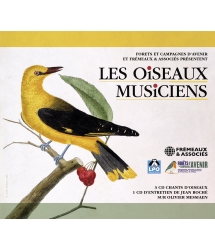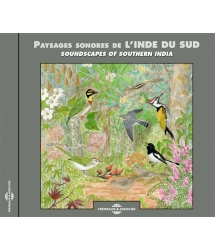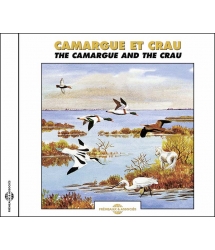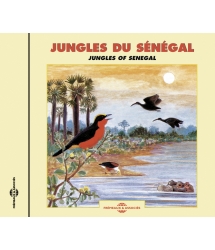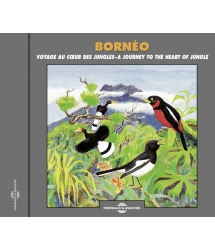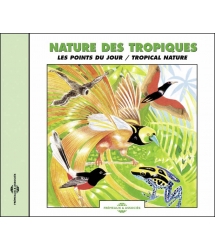- Our Catalog
- Philosophy
- Philosophers of the 20th century and today
- History of Philosophy (PUF)
- Counter-History and Brief Encyclopedia by Michel Onfray
- The philosophical work explained by Luc Ferry
- Ancient thought
- Thinkers of yesterday as seen by the philosophers of today
- Historical philosophical texts interpreted by great actors
- History
- Books (in French)
- Social science
- Historical words
- Audiobooks & Literature
- Our Catalog
- Jazz
- Blues
- Rock - Country - Cajun
- French song
- World music
- Africa
- France
- Québec / Canada
- Hawaï
- West Indies
- Caribbean
- Cuba & Afro-cubain
- Mexico
- South America
- Tango
- Brazil
- Tzigane / Gypsy
- Fado / Portugal
- Flamenco / Spain
- Yiddish / Israel
- China
- Tibet / Nepal
- Asia
- Indian Ocean / Madagascar
- Japan
- Indonesia
- Oceania
- India
- Bangladesh
- USSR / Communist songs
- World music / Miscellaneous
- Classical music
- Composers - Movie Soundtracks
- Sounds of nature
- Our Catalog
- Youth
- Philosophy
- News
- How to order ?
- Receive the catalog
- Manifesto
- Dictionnary











- Our Catalog
- Philosophy
- Philosophers of the 20th century and today
- History of Philosophy (PUF)
- Counter-History and Brief Encyclopedia by Michel Onfray
- The philosophical work explained by Luc Ferry
- Ancient thought
- Thinkers of yesterday as seen by the philosophers of today
- Historical philosophical texts interpreted by great actors
- History
- Books (in French)
- Social science
- Historical words
- Audiobooks & Literature
- Our Catalog
- Jazz
- Blues
- Rock - Country - Cajun
- French song
- World music
- Africa
- France
- Québec / Canada
- Hawaï
- West Indies
- Caribbean
- Cuba & Afro-cubain
- Mexico
- South America
- Tango
- Brazil
- Tzigane / Gypsy
- Fado / Portugal
- Flamenco / Spain
- Yiddish / Israel
- China
- Tibet / Nepal
- Asia
- Indian Ocean / Madagascar
- Japan
- Indonesia
- Oceania
- India
- Bangladesh
- USSR / Communist songs
- World music / Miscellaneous
- Classical music
- Composers - Movie Soundtracks
- Sounds of nature
- Our Catalog
- Youth
- Philosophy
- News
- How to order ?
- Receive the catalog
- Manifesto
- Dictionnary
JUNGLES OF BORNEO
FREMEAUX & ASSOCIES
Ref.: FA629
Author : 23|130
Artistic Direction : Remy Bruckert
Label : Frémeaux & Associés
Total duration of the pack : 1 hours 12 minutes
Nbre. CD : 1
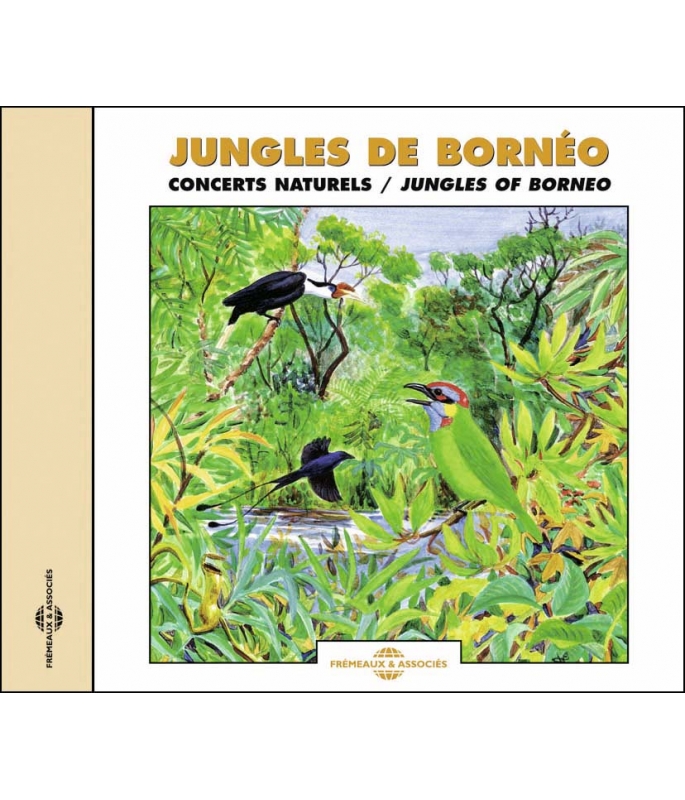
JUNGLES OF BORNEO
JUNGLES OF BORNEO
“Borneo is the second largest island on earth and the largest of the Indonesian archipelago. It is at a real crossroads with Java, the Malaysian peninsula, the Philippines and the Sulawesi islands. The eight diurnal concerts on this disc were recorded during June, July & August by Rémy Bruckert and mixed by Thierry Gaultier. They allow the listener to hear to the outstanding ornithological richness of Borneo : no less than 650 species of birds have been found here, about thirty are endemic.” Patrick Frémeaux & Jean C. Roché

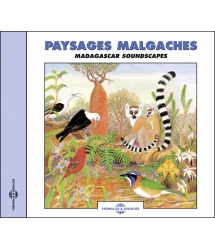
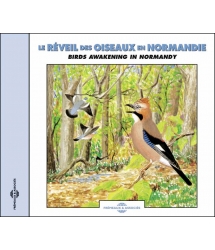
-
PisteTitleMain artistAutorDurationRegistered in
-
1GIBBONSons de la nature00:00:301993
-
2Barbu bigarréRed-crowned Barbet (Megalaima rafflesii)00:01:111993
-
3Couroucou de DiardBlue-crowned Trogon (Harpactes diardii)00:00:521993
-
4Sourd des mangrovesMangrove Whistler (Pachycephala grisola)00:02:081993
-
5Mainate religieuxHill Myna (Gracula religiosa)00:00:471993
-
6Calao en volCalao in flight (Buceros vigil)00:01:281993
-
7Engoulevent malaisMalaysian Eared-nightjar (Eurostopodus temminckii)00:01:061993
-
8Pic meunierGreat Slaty Woodpecker (Mulleripicus pulverulentus)00:01:571993
-
9MACAQUE À LONGUE QUEUESons de la nature00:02:181993
-
10Bulbul MorneWhite-eyed Bulbul (Pycnonotus simplex)00:01:321993
-
11Couturière à tête rousseAshy Tailorbird (Orthotomus ruficeps)00:01:131993
-
12Commère à ailes brunesChesnut-winged babbler (Stachyris erythroptera)00:01:141993
-
13Shama MalabarWhite-rumped Shama (Copsychus malabaricus)00:01:321993
-
14GIBBON 2Sons de la nature00:00:371993
-
15Perruche à longue queueLong-tailed Parakeet (Psittacula longicauda)00:00:371993
-
16Drongo du ParadisAsian Paradise-Flycatcher (Terpsiphone paradisi)00:03:191993
-
17Coucou IndienIndian Cuckoo (eudynamis orientalis)00:03:021993
-
18Timalie Mésange cousineSooty-capped Babbler (Malacopteron affine)00:00:191993
-
19Timalie Mésange cousineSooty-capped Babbler (Malacopteron affine)00:01:101993
-
20Couroucou de DuvaucelScarlet-rumped Trogon (Harpactes Duvaucelii)00:02:181993
-
21Barbu à moustachesGold-whiskered Barbet (Megalaima chrysopogon)00:00:161993
-
22Irène FéeAsian Fairy-bluebird (Irena puella)00:01:561993
-
23Gobe Mouche de Paradis d'asieAsian Paradise-Flycatcher (Terpsiphone paradisi)00:01:191993
-
24Tourterelle TurvertEmerald Dove (Chalcophaps indica)00:00:541993
-
25DÉBUT DE CONCERTSons de la nature00:00:261993
-
26VAGUE DE CHAUVES SOURISSons de la nature00:00:161993
-
27GRENOUILLES ARBORICOLESSons de la nature00:00:181993
-
28GECKOSons de la nature00:00:211993
-
29CIGALESSons de la nature00:01:091993
-
30GRENOUILLES TERRESTRESSons de la nature00:02:131993
-
31DÉBUT DE CONCERT 2Sons de la nature00:00:141993
-
32Timalie à gorge striéeStriped Tit-Babbler (Macronous gularis)00:00:211993
-
33Timalie à poitrine blancheWhite-breasted Babbler (Stachyris grammiceps)00:00:151993
-
34Calao à casque rougeWrinkled Hornbill (Aceros corrugatus)00:02:101993
-
35Couturière griseAshy Taylorbird (Orthotomus ruficeps)00:00:521993
-
36Corneille à bec minceSlender-billed Crow (Corvus enca)00:00:121993
-
37Loriot à gorge noireDark-throated Oriole (Oriolus xanthonotus)00:00:521993
-
38Brève grenadineGarnet Pitta (Pitta granatina)00:01:461993
-
39Calao à casque rondHelmeted Hornbill (Buceros vigil)00:00:501993
-
40Calao à casque rond 2Helmeted Hornbill (Buceros vigil)00:00:561993
-
41Grand VerdinGreater Green Leafbird (Chloropsis sonnerati)00:00:151993
-
42Coucal de ChineBubut besar (Centropus sinensis)00:02:441993
-
43Barbu à sourcils JauneYellow Crowned Barbet (Megalaima henricii)00:01:421993
-
44Bulbul à tête noireBlack-crested Bulbul (Pycnonotus melanicterus)00:01:011993
-
45Bulbul à tête jauneStraw-headed Bulbul (Pycnonotus zeylanicus)00:01:111993
-
46DEBUT DE CONCERT 3Sons de la nature00:00:141993
-
47Barbu à gorge noireBornean Barbet (Megalaima eximia)00:00:161993
-
48Bouscarle de MullerSunda Bush-Warbler (Cettia vulcania)00:01:071993
-
49Pie de MalaisieSunda Treepie (Dendrocitta occipitalis)00:01:221993
-
50DEBUT DE CONCERT 4Sons de la nature00:00:171993
-
51Milan sacréBrahminy Kite (Haliastur indus)00:02:221993
-
52Barbu à oreillons bleusBlue-eared Barbet (Megalaima australis)00:03:051993
-
53Martin-chasseur du CapStork-billed Kingfisher (Pelargopsis capensis)00:00:321993
-
54Bulbul à ailes vertesAshy Bulbul (Hemixos flavala)00:02:541993
-
55Calao de MalabarMalabar Pied-Hornbill (Anthracoceros coronatus)00:01:381993
-
56DEBUT DE CONCERT 5Sons de la nature00:02:021993
-
57Petit-duc roussâtreReddish Scops-Owl (Otus rufescens)00:03:111993
JUNGLES DE BORNÉO
JUNGLES DE BORNÉO
CONCERTS NATURELS / JUNGLES OF BORNEO
À Jérémie & Léonor
Jungles de Bornéo
Est-il vraiment besoin de présenter cette île mythique de Bornéo ? Qui n’a en effet entendu parler, au moins une fois dans sa vie, de l’enfer de ses jungles épaisses, ou de ses effroyables habitants coupeurs de têtes du temps jadis ? Bornéo est la deuxième île de la planète par sa surface, et aussi la plus grosse de l’archipel des Grandes Iles de la Sonde. Elle est située à un véritable carrefour : au nord de Java, à l’est de la péninsule malaise, au sud-ouest de l’archipel des Philippines, et enfin à l’ouest des îles Célèbes. C’est aussi une île dépourvue d’activité volcanique dont l’ouest (l’état de Sarawak) et le nord (l’état de Sabah) appartiennent à la Malaisie, et, le reste (Kalimantan) à l’Indonésie. La déforestation va bon train à Bornéo, mais malgré tout, la forêt couvre encore des surfaces importantes, surtout au centre de l’île. Du point de vue ornithologique, Bornéo appartient à la région orientale et plus précisément à sa partie indo-malaise. On y trouve pas moins de 650 espèces d’oiseaux dont environ une trentaine sont endémiques. Les huit concerts diurnes et les deux concerts nocturnes de ce disque ont été enregistrés en juin, juillet & août 1992 par Rémy Bruckert. Tout le travail de sélection & de mixage des meilleurs morceaux a été effectué par Thierry Gaultier dans les studios du CEBA à Mens. Nous tenons à remercier tout particulièrement Jean-Claude Porchier du CORIF (Centre Ornithologique de la Région Ile de France) pour ses compte-rendus de voyages en Indonésie et ses conseils de dernière minute ; Robyn Hill, secrétaire du NSW FOC (New South Wales Field Ornithological Club) pour son aide précieuse sur le terrain à Sarawak et Sabah ; et enfin, Bas Van Balen, correspondant de la Birdlife International à Bogor en Indonésie, pour son travail minutieux de réécoute qui a permis d’ajouter de nombreuses identifications.
Rémy Bruckert
Metro Manila, le 7 avril 1993
© 1993 SITTELLE – 2007 FRÉMEAUX & ASSOCIÉS
Ce CD contient :
A. Concert de l’aube au parc national de Tanjung Puting, Kalimantan
L’essentiel de ce parc de 305 000 ha est constitué d’une forêt poussant les pieds dans l’eau. Aussi, le meilleur moyen est de louer un “klotok”, le bateau de pêcheur local, pour faire la visite. C’est d’un tel bateau que ce concert a été enregistré, concert où dominent les Gibbons mais aussi Engoulevents, Barbus, Timalies & Mainates.
B. Concert matinal au parc national de Bako, Sarawak
Difficile d’imaginer plus grande variété d’habitats et paysages dans un aussi petit parc. Sur ses
2 742 ha, Bako offre mangrove, plage et falaises escarpées, plateau aride, forêt sèche et forêt humide. On y rencontre le Macaque à longue queue, que l’on entend dans ce concert, et aussi le Nasique, ce singe à gros nez, endémique de Bornéo devenu rare. Le final du concert est donné par le mélodieux Shama malabar.
C. Concert de l’aube à la réserve de Sepilok, Sabah
La forêt de Sepilok est célèbre pour son centre de réhabilitation à la vie sauvage des grands singes Orang-outans orphelins ou anciennement domestiqués. Mais ceux-ci ne sont pas très bavards. Par contre, les Gibbons se font entendre ici en compagnie du Drongo de paradis, du Coucou indien, de Couturières et Bulbuls.
D. Concert matinal au parc national du Mont Mulu, Sarawak
Le parc du Mont Mulu (2 376 m), le plus grand de Sarawak, possède une forêt primaire d’arbres géants. Leur épaisse canopée en forme de chou-fleur ne laissent filtrer que peu de lumière au sol. C’est à cette hauteur de plus de 50 m que vit la plupart des oiseaux qui trouvent là leur repas de fruits ou/et d’insectes. C’est le cas des Barbus dont on entend le chant rythmé dominant ce concert. Autre paire de manches que d’arriver à les apercevoir à contre-jour !
E. Concert nocturne au parc national du Mont Mulu, Sarawak
Le sol calcaire du parc de Mont Mulu est percé d’énormes grottes peuplées de millions de chauve-souris. Chaque jour, au crépuscule, on peut assister à leur envol par paquet de plusieurs milliers dont les ailes bruissent au début de ce concert. Lorsque la dernière est sortie, il fait nuit. Grenouilles terrestres et arboricoles prennent la relève. Elles ne s’arrêteront qu’au petit matin.
F. Concert de fin d’après-midi au parc national de Kutaï, Kalimantan
C’est un long chemin pour atteindre Mentoko où se trouvent les forêts préservées du feu et des tronçonneuses. Là habitent cerfs et sangliers, et aussi, orang-outans comme en témoignent les nids construits chaque soir à la cime des arbres où ceux-ci passent la nuit. C’est aussi le royaume des Calaos dont on peut entendre le rire ici. On n’échappe pas une fois de plus aux marteaux des Barbus et on retrouve les jolies phrases du Shama malabar.
G. Concert du matin de bonne heure à Poring Hot Springs, Sabah
À l’Est du Mont Kinabalu, les sources chaudes de Poring riches en soufre ont été canalisées dans des baignoires en plein air. Dans la forêt, un système de passerelles & plates-formes construit dans la canopée permet (enfin !) l’observation d’un bon nombre d’oiseaux mais aussi d’écureuils et lézards volants.
H. Concert de l’après-midi au parc national du Mont Kinabalu, Sabah
Mont Kanabalu avec ses 4 801 m culmine à Bornéo. La diversité florale et faunique du parc riche en espèces endémiques a été reconnue dès 1851 par Sir Hugh Lowe et explorée plus tard par John Whitehead en 1888 durant deux années. Ce concert est enregistré dans l’étage des forêts de chênes et châtaigners entre 1 500 et 2 000 m juste avant l’apparition des forêts moussues.
I. Concert du matin au bord de la rivière Kinabatangan, Sabah
Les jungles de cette région de plaine inondée bien que menacées par les plantations de palmiers possèdent encore de grandes populations de nasiques, orang-outans, rhinocéros, éléphants,… On peut y voir aussi la très rare Cigogne de Bornéo, Ciconia stormi. Ce concert est dominé par les plaintes d’un Milan sacré chassé par un Drongo de paradis.
J. Concert nocturne au bord de la rivière Kinabatangan, Sabah
Ce concert a été enregistré au bord d’un des nombreux lacs formés par les bras morts de la rivière. Insectes et grenouilles se disputent la première place. On entend au loin le hululement du Petit-duc roussâtre.
Liste des espèces apparaissant dans les concerts
Les index, numérotés de 1 à 57, permettent de repérer les espèces de premier plan. Ils indiquent l’apparition la plus évidente, qui n’est pas toujours la première dans le concert. Les espèces non indexées, en caractères plus petits, sont entendues en arrière-plan. Chaque entrée de la liste indique le nom français, le ou les noms indonésiens quand ils sont connus, et le nom scientifique en italique.
A. Tanjung Puting, Kalimantan :
1. Gibbon sp. / Owa Owa / Hylobates sp.
• Timalie à couronne rousse / Kancilan kepala merah besar / Malacopteron magnum
2. Barbu bigarré / Bultok pancawarna / Megalaima rafflesii
• Commère à ailes brunes / Tepus sayap merah / Stachyris erythroptera
• Barbu à oreillons bleus / Tenggeret, Bultok telinga biru / Megalaima australis
• Coryllis à calotte bleue / Serindit atas kepala biru, Entelit / Loriculus galgulus
3. Couroucou de Diard / Trogon Diard, Papau / Harpactes diardii
4. Sourd des mangroves / Sriwang rawa / Pachycephala grisola
5. Mainate religieux / Tiong, Beo / Gracula religiosa
• Timalie-mésange rayée / Ciung air setrip / Macronous gularis
• Timalie cousine / Kancilan atas kepala hitam / Malacopteron affine
• Monarque bleu à nuque noire / Kehicap ranting / Hypothymis azurea
6. Vol de Calao / Rangkong yang terbang
7. Engoulevent malais / Cabak telinga melayu, Taktarau / Eurostopodus temminckii
8. Pic meunier / Pelatuk besar kelabu / Mulleripicus pulverulentus
B. Bako, Sarawak :
9. Macaque à longue queue / Kera / Macaca sp.
• Timalie-mésange rayée / Ciung air setrip / Macronous gularis
• Drongo de paradis / Srigunting batu, Saeran bandera batu / Dicrurus paradiseus
10. Bulbul morne / Corok-corok / Pycnonontus simplex
• Timalie à poitrine blanche / Kancilan Blyth, Tinjak perut putih / Trichastoma rostratum
11. Couturière à tête rousse / Cici mahkota coklat / Orthothomus sericeus
12. Commère à ailes brunes / Tepus sayap merah / Stachyris erythroptera
13. Shama Malabar / Kucican hutan / Copsychus malabaricus
C. Sepilok, Sabah :
14. Gibbon sp. / Owa owa / Hylobates sp.
• Couturière à tête rousse / Cici mahkota coklat / Orthotomus sericeus
15. Perruche à longue queue / Betet ekor panjang, Betet Bangka / Psittacula longicauda
16. Drongo de paradis / Srigunting batu, Saeran bandera batu / Dicrurus paradiseus
17. Coucou indien / Belanda mabok / Cuculus micropterus
D. Mont Mulu, Sarawak :
18. Timalie cousine / Kancilan atas kepala hitam / Malacopteron affine
• Barbu arlequin / Bultok kerongkongan merah, Bultok leher merah / Megalaima mystacophonos
19. Timalie-mésange laineuse / Ciung air punggung bulu / Macronous ptilosus
• Commère à ailes brunes / Tepus sayap merah / Stachyris erythroptera
• Dicée à ventre orange / Burung bunga api / Dicaeum trigonostigma
20. Couroucou de Duvaucel / Trogon pantat merah, Beragai / Harpactes duvaucelli
• Barbu à oreillons bleus / Tenggeret, Bultok telinga biru / Megalaima australis
21. Barbu à moustaches / Lopong, Bultok kumis mas / Megalaima chrysopogon
22. Irène fée / Kacembang / Irena puella
23. Gobe-mouches de paradis d’Asie / Burung sriwang / Tersiphone paradisi
• Timalie moustac / Kancilan kumis, Tinjak kumis / Malacopteron magnirostre
• Timalie à couronne écaillée / Kancilan topi sisik / Malacopteron cinereum
• Shama Malabar / Kucican hutan / Copsychus malabaricus
24. Tourterelle turvert / Delimukan / Chalcophaps indica
• Drongo de paradis / Sringunting batu, Saeran bandera batu / Dicrurus paradiseus
E. Mont Mulu, Sarawak :
25. Début du concert
26. Vague de chauves-souris / Kelelawar kelelawar yang terbang
27. Grenouilles arboricoles / Kodok pohon
28. Gecko / Cecak
29. Cigales / Tonggeret
30. Grenouilles terrestres / Kodok tanah
F. Kutaï, Kalimantan :
31. Début du concert
32. Timalie-mésange rayée / Ciung air setrip / Macronous gularis
• Barbu à moustaches / Lopong, Bultok kumis mas / Megalaima chrysopogon
33. Timalie à poitrine blanche / Kancilan Blyth, Tinjak perut Putih / Trichastoma rostratum
34. Calao à casque rouge / Julang paruh merah, Kukuk / Aceros corrugatus
• Couturière à tête rousse / Cici mahkota coklat / Orthotomus sericeus
• Shama Malabar / Kucican hutan / Copsychus malabaricus
• Mainate religieux / Tiong, Beo / Gracula religiosa
35. Couturière grise / Cinenen kelabu / Orthotomus ruficeps
36. Corneille à bec mince / Gagak hutan / Corvus enca
37. Loriot à gorge noire / Kepodang hutan / Oriolus xanthonotus
38. Brève grenat / Pita merah / Pitta granatina
• Coucou indien / Belanda mabok / Cuculus micropterus
• Coucou sournicou / Kedasi hitam / Surniculus lugubris
39. Calao à casque rond / Enggang gading / Rhinoplax vigil
40. Idem, rire terminant la phrase.
G. Poring Hot Springs, Sabah :
41. Grand Verdin / Burung daun besar / Chloropsis sonnerati
42. Coucal de Chine / Bubut besar / Centropus sinensis
• Barbu à oreillons bleus / Tenggeret, Bultok telinga biru / Megalaima australis
• Barbu à moustaches / Lopong, Bultok kumis mas / Megalaima chrysopogon
• Petit Arachnotère / Burung jantung / Arachnothera longirostra
• Barbu à sourcils jaunes / Bultok topi kuning / Megalaima henricii
• Shama Malabar / Kucican hutan / Copsychus malabaricus
• Dicée à ventre orange / Burung bunga api / Dicaeum trigonostigma
43. Barbu arlequin / Bultok kerongkongan merah / Megalaima mystacophonos
• Couturière à tête rousse / Cici mahkota coklat / Orthotomus sericeus
44. Bulbul à tête noire / Kucirang, Empuru kepala hitam / Pycnonotus atriceps
45. Bulbul à tête jaune / Cucakrawa, Empuru buaya / Pycnonotus zeylanicus
H. Mont Kinabalu, Sabah :
46. Début du concert
47. Barbu à gorge noire / Bultok kerongkongan hitam / Megalaima eximia
48. Bouscarle de Müller / Perenjak gunung / Cettia vulcania
• Tourterelle à tête rousse / Kouran / Macropygia ruficeps
49. Pie de Malaisie / Tankeruli / Dendrocitta occipitalis
I. Rivière Kinabatangan, Sabah :
50. Début du concert
• Coucal de Chine / Bubut besar / Centropus sinensis
51. Milan sacré / Elang bondol, Elang merah, Wulung / Haliastur indus
• Timalie à poitrine blanche / Kancilan Blyth, Tinjak perut putih / Trichastoma rostratum
• Commère à ailes brunes / Tepus sayap merah / Stachyris erythroptera
• Dicée à ventre orange / Burung bunga api / Dicaeum trigonostigma
• Shama Malabar / Kucican hutan / Copsychus malabaricus
• Couturière grise / Cinenen kelabu / Orthotomus ruficeps
52. Barbu à oreillons bleus / Tenggeret, Bultok telinga biru / Megalaima australis
• Couroucou de Duvaucel / Trogon pantat merah, Beragai / Harpactes duvaucelii
• Timalie cousine / Kancilan atas kepala hitam / Malacopteron affine
53. Martin-chasseur du Cap / Raja udang merah / Pelargopsis capensis
• Souï-manga de Malacca / Burung madu kelapa / Anthreptes malacensis
54. Bulbul à ailes olive / Mancrang / Pycnonotus plumosus
55. Calao de Malabar / Kangkareng perut putih / Anthracoceros coronatus
• Mainate religieux / Tiong, Beo / Gracula religiosa
J. Rivière Kinabatangan, Sabah :
56. Début du concert
57. Petit-duc roussâtre / Celepuk merah / Otus rufescens
Rémy Bruckert, Metro manila, 7 avril 1993
© 1993 SITTELLE – 2007 FRÉMEAUX & ASSOCIÉS
To Jérémie & Léonor
Jungles of Borneo
Is there really a need to describe this mythical island of Borneo ? Who, at least once in there lives, hasn’t heard of the hell of its impenetrable jungles, where the frightening inhabitants were once head hunters ? Borneo is the second largest island on earth, and the largest of the indonesian archipelago. It is at a real crossroads : with Java to the north, the Malaysian peninsula to the east, the Philippines to the south-west and the Sulawesi islands to the west. An island without volcanic activity of which the west (state of Sarawak) and north (state of Sabah) belong to Malaysia, and the rest (Kalimantan) to Indonesia. Deforestation continues apace in Borneo, but even so, forest covers large areas, particularly in the centre of the island. From an ornothological point of view, Borneo belongs to the indo-malaysian part of the Oriental region. No less than 650 species of bird have been found here, about thirty are endemic. The eight diurnal and two nocturnal concerts on this disc were recorded during June, July & August 1992 by Rémy Bruckert. The work of selecting and mixing the best parts was undertaken by Thierry Gaultier at the ACBS studios in Mens. We should particularly like to thank Jean-Claude Porchier of the CORIF (Centre Ornithologique de la Région Ile de France) for an account of his trips to Indonesia and his last minute advise ; Robyn Hill, secretary of the NSW FOC (New South Wales Field Ornithological Club) for his invaluable aid in the field in Sarawak and Sabah ; and lastly, Bas van Balen, Birdlife International correspondant at Bogor in Indonesia, for his detailed listening work which allowed for the identification of many more sounds.
Rémy Bruckert, Metro manila, 7th April 1993
Translated in English by Tony Williams
© 1993 SITTELLE – 2007 FRÉMEAUX & ASSOCIÉS
This CD includes :
A. A dawn chorus in the Tanjung Puting National Park, Kalimantan
Most of the 305,000 ha of this park consists of a forest growing with its trunks in water. The best means of visiting the area is by hiring a “klotok”, the boat used by local fishermen. This concert was recorded from such a boat, a recording dominated by Gibbons, with Nightjars, Barbets, Babblers and Mynas.
B. Morning concert in Bako National Park, Sarawak
It’s difficult to imagine such a great diversity of habitats in such a small park. In its 2742 ha, Bako has mangrove, beaches and sheer cliffs, arid plateau, both dry and wet forest. Here we find the Long-tailed Macaque, which can be heard in the concert, and the Proboscis monkey, the monkey with the inflated nose, endemic to Borneo and now rare. The final to the concert is given by the melodious White-rumped Shama.
C. Dawn chorus at the Sepilok Reserve, Sabah
The Sepilok forest is best known for its back-to-the-wild rehabilitation centre for orphaned or ex-captive Orang-utans. These animals don’t make a lot of sound however. Gibbons, on the contrary, can easily be heard in company with the Greater Racket-tailed Drongo, Indian Cuckoo, Tailorbirds and Bulbuls.
D. Dawn chorus in the Mount Mutu National Park, Sarawak
The Mount Mulu (2376 m) park, the largest in Sarawak, has a primary forest of giant trees. Their enormous canopy in the shape of a cauliflower lets little light pass to the ground. Most of the birds live here, some 50 meters up, feeding on fruits and/or insects. Such is the case with the barbets, their rythmic songs can be heard dominating this concert. But it’s another matter spotting them, against the light.
E. Nocturnal concert in the Mount Mulu national park, Sarawak
The limestone ground of the Mount Mulu park is pierced with enormous caves inhabited by millions of bats. Each evening, at dusk, they can be seen leaving in groups of thousands, the murmur of their wings begins this concert. Night has fallen by the time the last one leaves. Ground and tree frogs take their place. They won’t stop until dawn.
F. Late afternoon concert in Kutaï National Park, Kalimantan
It’s a long way to Mentoko, where the forest is protected from fire and chain-saws. Here live deer and wild boar, and, Orang-utans as proven by the presence of their beds, built each evening in the treetops and where they pass the night. It’s also the kingdom of Hornbills whose laugh can be heard here. Once again, we can’t avoid the hammering of Barbets and the jolly phrases of the White-rumped Shama.
G. Early morning concert at Poring Hot Springs, Sabah
To the east of Mount Kinabalu, the waters of the sulphur rich Poring hot springs have been channelled into open-airs baths. In the forest, a system of cat-walks and platforms built in the capony allows (at last) for the observation of many birds as well as Squirrels and flying Lizards.
H. Afternoon concert in the Mount Kinabalu National Park, Sabah
At 4801 m, the top of Mount Kinabalu is the highest point in Borneo. The diversity of the park’s plants and animals, and the richness, in endemic species was recognized as long ago as 1851 by Sir Hugh Lowe and later explored by John Whitehead for two years beginning in 1888. This concert was recorded in the layer of forest containing oaks and chesnuts between 1500 and 2000 m just below the level where moss covered trees begin to appear.
I. Morning concert on the banks of Kinabatangan River, Sabah
The jungle in this area of flooded plain, although threatened by palm plantation still contains good populations of Proboscis monkeys, Orang-utans, rhinoceros, elephants,… The very rare Storm’s Stock Ciconia stormi may be seen here. This concert is dominated by the complaints of a Brahminy Kite being chassed by a Greater Racket-tailed Drongo.
J. Nocturnal concert on the banks of Kinabatangan River, Sabah
This concert was recorded on the side of one of the numerous ox-bow lakes formed by the river. Insects and frogs vie for first place. The hooting of a Reddish Scops Owl can be heard in the distance.
List of species appearing in the concerts
The index, numbered from 1 to 57, allows for the locating of the more audible species. They indicate the most obvious occurences, and don’t, therefore, always correspond to species’ first appearance in the concert. Non indexed species, in smaller type, are heard in the back ground. Each entry indicates the name in English, Indonesian (when known), and the scientific name.
A. Tanjung Puting, Kalimantan :
1. Gibbon sp. / Owa Owa / Hylobates sp.
• Rufous-crowned Babbler / Kancilan kepala merah besar / Malacopteron magnum
2. Red-crowned (Many-coloured) Barbet / Bultok pancawarna / Megalaima rafflesii
• Chestnut-winged Babbler / Tepus sayap merah / Stachyris erythroptera
• Blue-eared (Little) Barbet / Tenggeret, Bultok telinga biru / Megalaima australis
• Blue-crowned Hanging-Parrot / Serindit atas kepala biru, Entelit / Loriculus galgulus
3. Diard’s Trogon / Trogon Diard, Papau / Harpactes diardii
4. Mangrove Whistler / Sriwang rawa / Pachycephala grisola
5. Hill (Talking) Myna / Tiong, Beo / Gracula religiosa
• Striped Tit-Babbler / Ciung air setrip / Macronous gularis
• Sooty-capped Babbler / Kancilan atas kepala hitam / Malacopteron affine
• Black-naped Monarch / Kehicap ranting / Hypothymis azurea
6. Hornbill flight / Rangkong yang terbang
7. Malaysian Eared Nightjar / Cabak telinga melayu, Taktarau / Eurostopodus temminckii
8. Great Slaty Woodpecker / Pelatuk besar kelabu / Mulleripicus pulverulentus
B. Bako, Sarawak :
9. Long-tailed Macaque / Kera / Macaca sp.
• Striped Tit-Babbler / Ciung air setrip / Macronous gularis
• Greater Racket-tailed Drongo / Srigunting batu, Saeran bandera batu / Dicrurus paradiseus
10. Cream-vented Bulbul / Corok-corok / Pycnonontus simplex
• White-chested Babbler / Kancilan Blyth, Tinjak perut putih / Trichastoma rostratum
11. Rufous-tailed Tailorbird / Cici mahkota coklat / Orthothomus sericeus
12. Chestnut-winged Babbler / Tepus sayap merah / Stachyris erythroptera
13. White-rumped Shama / Kucican hutan / Copsychus malabaricus
C. Sepilok, Sabah :
14. Gibbon sp. / Owa owa / Hylobates sp.
• Rufous-tailed Tailorbird / Cici mahkota coklat / Orthotomus sericeus
15. Long-tailed Parakeet / Betet ekor panjang, Betet Bangka / Psittacula longicauda
16. Greater Racket-tailed Drongo / Srigunting batu, Saeran bandera batu / Dicrurus paradiseus
17. Indian Cuckoo / Belanda mabok / Cuculus micropterus
D. Mont Mulu, Sarawak :
18. Sooty-capped Babbler / Kancilan atas kepala hitam / Malacopteron affine
• Red-throated (Gaudy) Barbet / Bultok kerongkongan merah, Bultok leher merah / Megalaima mystacophonos
19. Fluffy-backed Tit-Babbler / Ciung air punggung bulu / Macronous ptilosus
• Chesnut-winged Babbler / Tepus sayap merah / Stachyris erythroptera
• Orange-bellied Flowerpecker / Burung bunga api / Dicaeum trigonostigma
20. Scarlet-rumped Trogon / Trogon pantat merah, Beragai / Harpactes duvaucelii
• Blue-eared (Little) Barbet / Tenggeret, Bultok telinga biru / Megalaima australis
21. Gold-whiskered Barbet / Lopong, Bultok kumis mas / Megalaima chrysopogon
22. Asian Fairy Bluebird / Kacembang / Irena puella
23. Asian Paradise Flycatcher / Burung sriwang / Tersiphone paradisi
• Moustached Babbler / Kancilan kumis, Tinjak kumis / Malacopteron magnirostre
• Scaly-crowned Babbler / Kancilan topi sisik / Malacopteron cinereum
• White-rumped Shama / Kucican hutan / Copsychus malabaricus
24. Emerald Dove / Delimukan / Chalcophaps indica
• Greater Racket-tailed Drongo / Sringunting batu, Saeran bandera batu / Dicrurus paradiseus
E. Mont Mulu, Sarawak :
25. Beginning of the concert
26. Bats flight / Kelelawar kelelawar yang terbang
27. Tree frogs / Kodok pohon
28. Gecko / Cecak
29. Cicadas / Tonggeret
30. Ground frogs / Kodok tanah
F. Kutaï, Kalimantan :
31. Beginning of the concert
32. Striped Tit-Babbler / Ciung air setrip / Macronous gularis
• Gold-whiskered Barbet / Lopong, Bultok kumis mas / Megalaima chrysopogon
33. White-chested Babbler / Kancilan Blyth / Trichastoma rostratum
34. Wrinkled Hornbill / Julang paruh merah, Kukuk / Aceros corrugatus
• Rufous-tailed Tailorbird / Cici mahkota coklat / Orthotomus sericeus
• White-rumped Shama / Kucican hutan / Copsychus malabaricus
• Hill (Talking) Myna / Tiong, Beo / Gracula religiosa
35. Ashy Tailorbird / Cinenen kelabu / Orthotomus ruficeps
36. Slender-billed Crow / Gagak hutan / Corvus enca
37. Dark-throated Oriole / Kepodang hutan / Oriolus xanthonotus
38. Garnet Pitta / Pita merah / Pitta granatina
• Indian Cuckoo / Belanda mabok / Cuculus micropterus
• Drongo-Cuckoo / Kedasi hitam / Surniculus lugubris
39. Helmeted Hornbill / Enggang gading / Rhinoplax vigil
40. Idem, laughter ending the call.
G. Poring Hot Springs, Sabah :
41. Greater Green Leafbird / Burung daun besar / Chloropsis sonnerati
42. Greater Coucal / Bubut besar / Centropus sinensis
• Blue-eared (Little) Barbet / Tenggeret, Bultok telinga biru / Megalaima australis
• Gold-whiskered Barbet / Lopong, Bultok kumis mas / Megalaima chrysopogon
• Little Spiderhunter / Burung jantung / Arachnothera longirostra
• Yellow-crowned Barbet / Bultok topi kuning / Megalaima henricii
• White-rumped Shama / Kucican hutan / Copsychus malabaricus
• Orange-bellied Flowerpecker / Burung bunga api / Dicaeum trigonostigma
43. Red-throated (Gaudy) Barbet / Bultok kerongkongan merah / Megalaima mystacophonos
• Rufous-tailed Tailorbird / Cici mahkota cocklat / Orthotomus sericeus
44. Black-headed Bulbul / Kucirang, Empuru kepala hitam / Pycnonotus atriceps
45. Straw-headed Bulbul / Cucakrawa, Empuru buaya / Pycnonotus zeylanicus
H. Mont Kinabalu, Sabah :
46. Beginning of the concert
47. Black-throated (Bornean) Barbet / Bultok kerongkongan hitam / Megalaima eximia
48. Sunda Bush Warbler / Perenjak gunung / Cettia vulcania
• Little Cuckoo-Dove / Kouran / Macropygia ruficeps
49. Malaysian Treepie / Tankeruli / Dendrocitta occipitalis
I. Kinabatangan River, Sabah :
50. Beginning of the concert
• Greater Coucal / Bubut besar / Centropus sinensis
51. Brahminy Kite / Elang bondol, Elang merah, Wulung / Haliastur indus
• White-chested Babbler / Kancilan Blyth, Tinjak perut putih / Trichastoma rostratum
• Chestnut-winged Babbler / Tepus sayap merah / Strachyris erythroptera
• Orange-bellied Flowerpecker / Burung bunga api / Dicaeum trigonostigma
• White-rumped Shama / Kucican hutan / Copsychus malabaricus
• Ashy Tailorbird / Cinenen kelabu / Orthotomus ruficeps
52. Blue-eared (Little) Barbet / Tenggeret, Bultok telinga biru / Megalaima australis
• Scarlet-rumped Trogon / Trogon pantat merah, Beragai / Harpactes duvaucelii
• Sooty-capped Babbler / Kancilan atas kepala hitam / Malacopteron affine
53. Stork-billed Kingfisher / Raja undang merah / Pelargopsis capensis
• Plain-throated Sunbird / Burung madu kelapa / Anthreptes malacensis
54. Olive-winged Bulbul / Mancrang / Pycnonotus plumosus
55. Pied Hornbill / Kangkareng perut putih / Anthracoceros coronatus
• Hill (Talking) Myna / Tiong, Beo / Gracula religiosa
J. Kinabatangan River, Sabah :
56. Beginning of the concert
57. Reddish Scops Owl / Celepuk merah / Otus rufescens
Rémy Bruckert, Translated in English by Tony Williams
© 1993 SITTELLE – 2007 FRÉMEAUX & ASSOCIÉS
Droits audio : Frémeaux & Associés - La Librairie Sonore (Producteur initial : Sittelle ou Ceba) / Ecouter les chants d'oiseaux sur CD : Sons et ambiances naturelles des écosystèmes - Stéreo and digital recording of the natural landscape sound. Natural sound sceneries of écosystems, Voices of the Wild Life. Les droits de cet enregistrement sont protégés par la loi. Pour toute exploitation d’illustration sonore sur CD, DVD, CD-Rom, Télévision, Cinéma, Sites internet, scénographies (théâtre, musées…), l’autorisation et un devis gratuit peuvent être obtenus auprès de Frémeaux & Associés – fax : +33 (0)1 43.65.24.22 info@fremeaux.com
